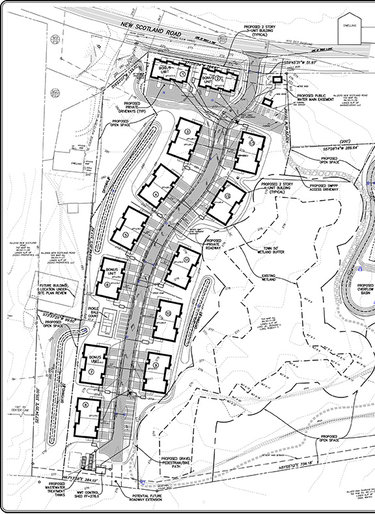New Scotland Road condos approved, 45 units to sell for upper $300K or more
NEW SCOTLAND — After three years and many meetings, the New Scotland Planning Board on June 6 approved a 45-unit condo project slated to be built across the street from Town Hall.
Long proposed as 50 units, the project was slimmed down in May because the developer could not meet New Scotland’s affordable-housing requirements and so did not receive the opportunity to build additional units.
The land, at 2080 New Scotland Road, is owned by Richard Long, but the applicant, Frank McCloskey, has been a partner at the project’s engineering firm, Hershberg & Hershberg. With the proposal receiving approval, Pigliavento Builders will take over as project owner.
The project was introduced in June 2021 as 72 apartments, a proposal that forced the town to make changes to its zoning law.
The new law allows for a base total of 40 units, with developers being eligible to earn a maximum of 10 additional units “in return for providing certain amenities to the town,” such as dedicating a percentage of total units to affordable housing; allowing public use of permanently preserved on-site open space; or meeting a number of energy-related provisions.
During the planning board’s April meeting, project attorney Andy Brick said six units would be set aside for prospective buyers who made 88 percent ($99,440) of the New Scotland median income, which is about $113,000 using 2022 figures. Another four units would be set aside for buyers whose income was 96 percent ($108,480) of the town’s median income.
The for-sale price of the affordable housing discussed during the meeting was $360,000 per unit.
Starting prices for the now-approved condos will be in the high $300’s to low $400’s.
No affordable housing
At the board’s May meeting, Brick explained the project would no longer set aside affordable units.
“As you may recall, regarding affordability, we were seeking an eight-point density bonus for providing at least 25% of the total housing units as permanently dedicated affordable housing,” Brick said. “Last month, we presented what we thought we could achieve in terms of reaching a lower percentage of Area Median Income (AMI). Your code states that the bonus is for moderate income, defined as 100 percent of AMI or lower.”
Brick said planning board attorney Crystal Peck had developed a formula for determining affordability and monthly costs, “concluding that PMI (private mortgage insurance) should be included” and, while the development team didn’t disagree with Peck’s analysis,” Brick said, “this additional monthly cost wasn’t in our original calculations.”
Brick said, when the additional cost of PMI was factored into the development team’s equation, it couldn’t “even reach the 88 percent AMI we had proposed, and we may not even be able to achieve the 100 percent we initially suggested.”
He also noted that, when affordable housing was proposed, the analysis was “based on a 6.5 [percent] interest rate, but it was over 7 percent this week.”
“With these moving targets and additional factors to consider, it has become an unworkable process from our perspective,” said Brick. “Our project is a for-sale product, but I believe the language in your code for the density bonus was envisioned for rental properties. We wanted to make it work, knowing how important affordability is, but we were trying to fit a square peg into a round hole.”
He continued, “At this point, we don’t think we can reach a level that would be satisfactory to you while keeping the project financially viable. We’re willing to continue discussions and crunch numbers, but we believe a more viable alternative would be to withdraw our request for the affordable density bonus and the associated eight points. Instead, we propose reducing our project from 50 units to 45 units.”
The project was eligible for five additional units because of the development’s housing density and a promise of sidewalks and electric-vehicle charging stations.
Chairman Jeffrey Baker at that May meeting told Brick, “I appreciate the difficulty you had in trying to reach this goal. I agree with you; I think the way the code was written envisioned a lot more rental housing.”


